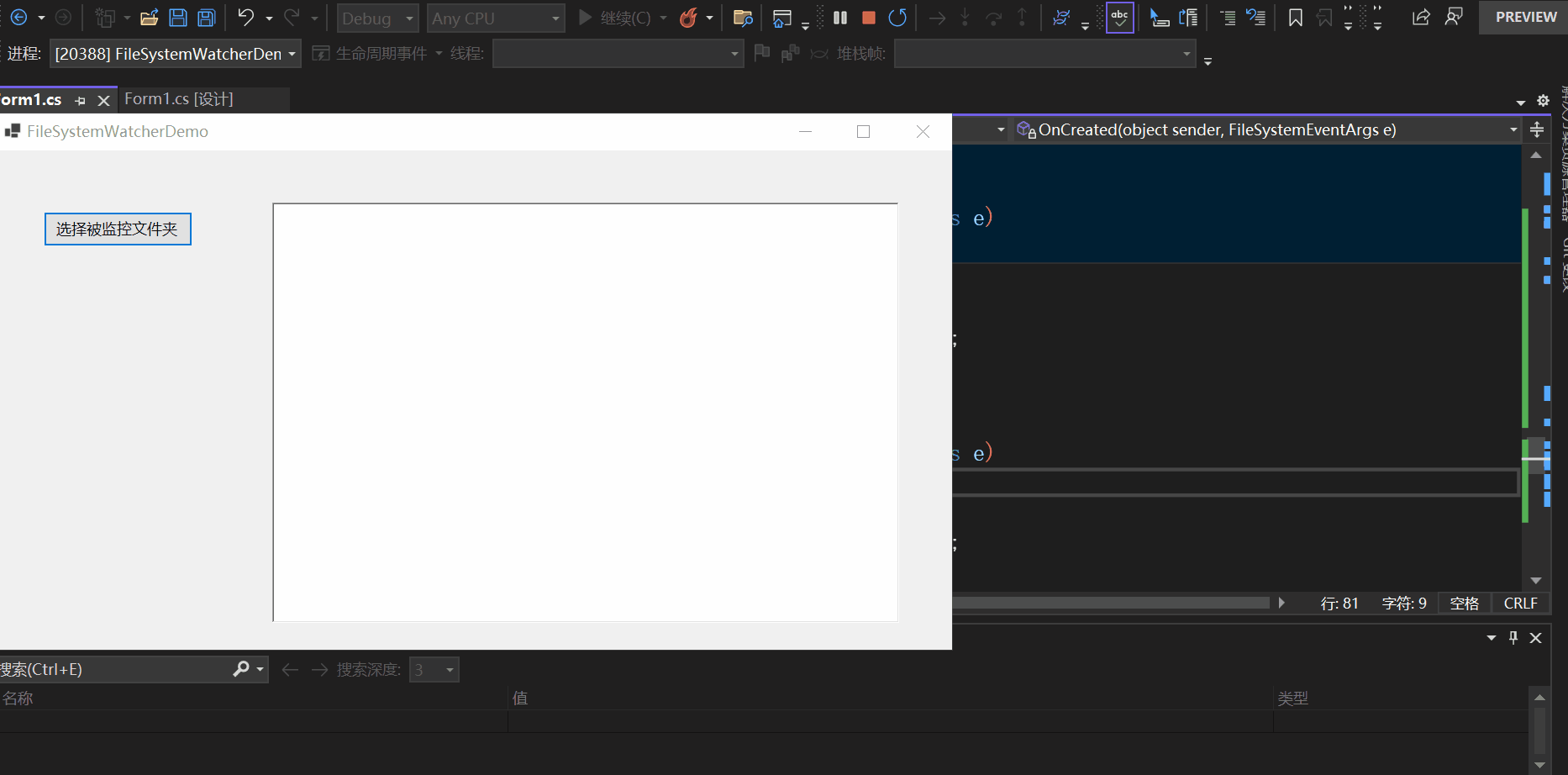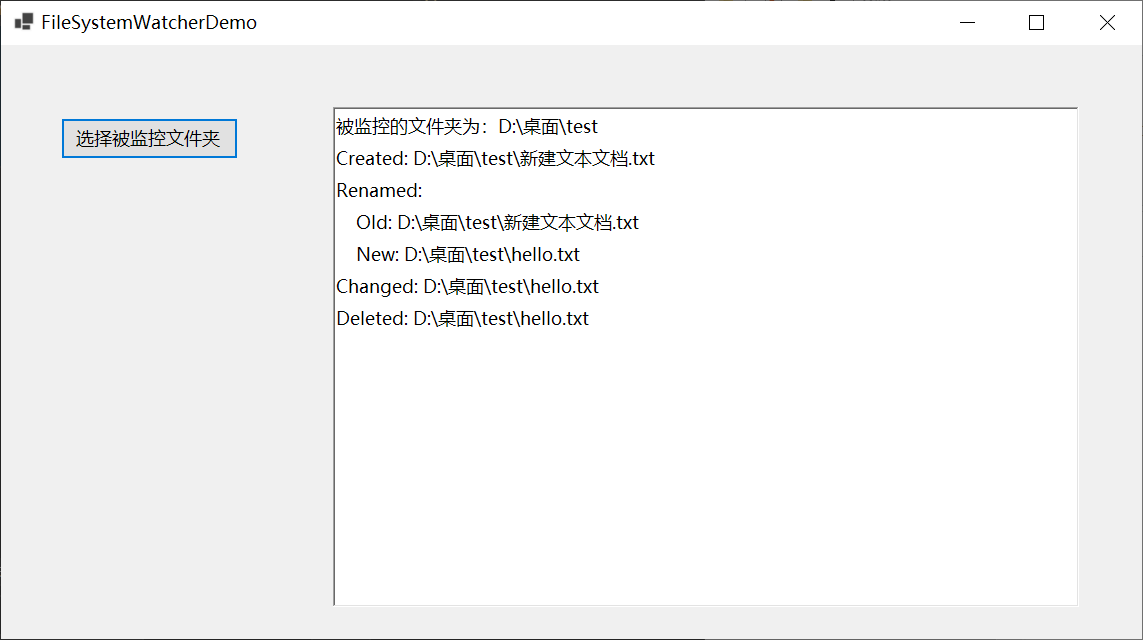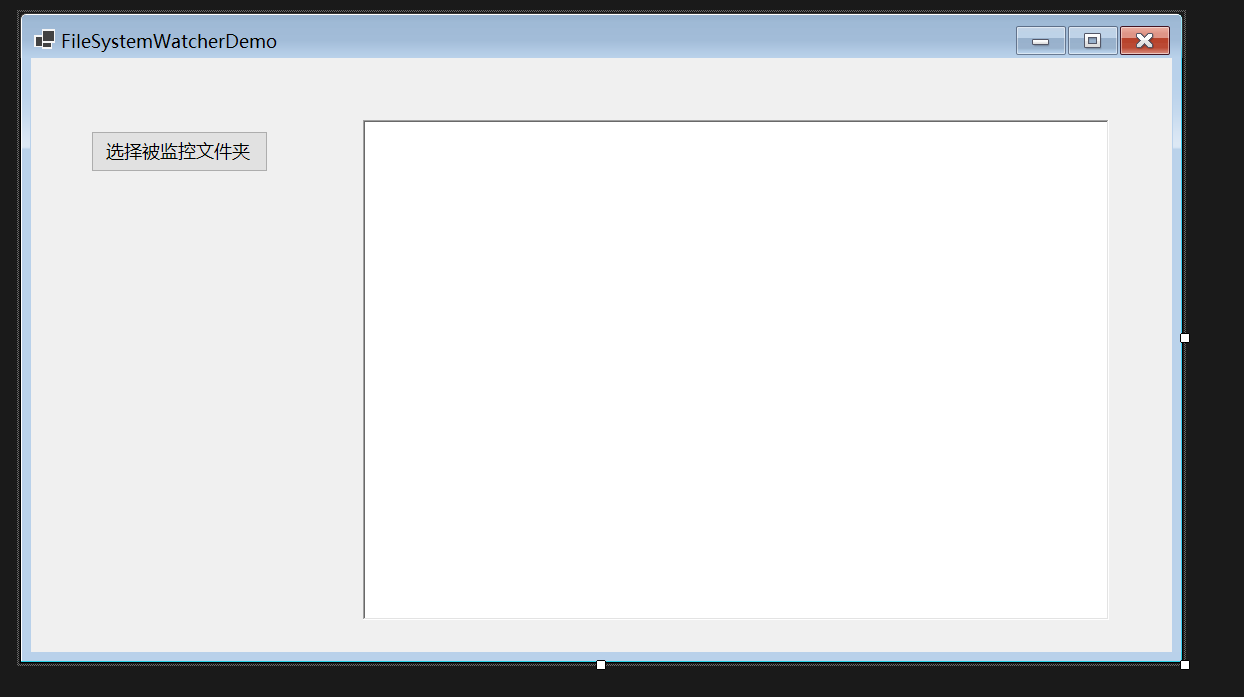前言?
有時(shí)候我們會(huì)有監(jiān)控電腦上某一個(gè)文件夾中文件變動(dòng)情況的需求,在本文中,我也會(huì)以一個(gè)具體的例子,說(shuō)明在C#中如何使用FileSystemWatcher類來(lái)實(shí)現(xiàn)上述需求。
效果?


具體實(shí)現(xiàn)?
如果你對(duì)C#如何監(jiān)控選定文件夾中文件的變動(dòng)情況感興趣,可以繼續(xù)往下閱讀。
界面設(shè)計(jì)
為了更好的演示效果,我這里winform的界面設(shè)計(jì)如下:

很簡(jiǎn)單,只有一個(gè)button與一個(gè)richtextbox,button用來(lái)指定被監(jiān)控的文件,richtextbox用來(lái)輸出一些信息。
全部代碼
namespace FileSystemWatcherDemo
{
public partial class Form1 : Form
{
public Form1()
{
InitializeComponent();
}
private void button1_Click(object sender, EventArgs e)
{
FolderBrowserDialog folderBrowserDialog = new FolderBrowserDialog();
folderBrowserDialog.Description = "選擇文件夾";
if (folderBrowserDialog.ShowDialog() == DialogResult.OK)
{
richTextBox1.Text = "";
string selectedFolder = folderBrowserDialog.SelectedPath;
richTextBox1.Text += $"被監(jiān)控的文件夾為:{selectedFolder}\r\n";
var watcher = new FileSystemWatcher($"{selectedFolder}");
watcher.NotifyFilter = NotifyFilters.Attributes
| NotifyFilters.CreationTime
| NotifyFilters.DirectoryName
| NotifyFilters.FileName
| NotifyFilters.LastAccess
| NotifyFilters.LastWrite
| NotifyFilters.Security
| NotifyFilters.Size;
watcher.Changed += OnChanged;
watcher.Created += OnCreated;
watcher.Deleted += OnDeleted;
watcher.Renamed += OnRenamed;
watcher.Filter = "*.txt";
watcher.IncludeSubdirectories = true;
watcher.EnableRaisingEvents = true;
}
else
{
MessageBox.Show("您本次沒(méi)有選擇文件夾!!!");
}
}
private void AppendMessageToRichTextBox(string message)
{
richTextBox1.Invoke(new Action(() =>
{
richTextBox1.AppendText(message + Environment.NewLine);
}));
}
private void OnChanged(object sender, FileSystemEventArgs e)
{
if (e.ChangeType != WatcherChangeTypes.Changed)
{
return;
}
AppendMessageToRichTextBox($"Changed: {e.FullPath}");
}
private void OnCreated(object sender, FileSystemEventArgs e)
{
string value = $"Created: {e.FullPath}";
AppendMessageToRichTextBox($"Created: {e.FullPath}");
}
private void OnDeleted(object sender, FileSystemEventArgs e)
{
AppendMessageToRichTextBox($"Deleted: {e.FullPath}");
}
private void OnRenamed(object sender, RenamedEventArgs e)
{
AppendMessageToRichTextBox($"Renamed:");
AppendMessageToRichTextBox($" Old: {e.OldFullPath}");
AppendMessageToRichTextBox($" New: {e.FullPath} ");
}
}
}
FileSystemWatcher的介紹
看過(guò)以上代碼,會(huì)發(fā)現(xiàn)核心就是FileSystemWatcher的使用。接下來(lái)我將介紹一下C#中的FileSystemWatcher類。
FileSystemWatcher是C#中的一個(gè)類,該類可以偵聽(tīng)文件系統(tǒng)更改通知,并在目錄或目錄中的文件發(fā)生更改時(shí)引發(fā)事件。
FileSystemWatcher的構(gòu)造函數(shù)
該類有三種構(gòu)造函數(shù),如下所示:
| 形式 | 含義 |
|---|
| FileSystemWatcher() | 初始化 FileSystemWatcher 類的新實(shí)例。 |
| FileSystemWatcher(String) | 初始化 FileSystemWatcher 類的新實(shí)例,給定要監(jiān)視的目錄。 |
| FileSystemWatcher(String, String) | 初始化 FileSystemWatcher類的新實(shí)例,給定要監(jiān)視的目錄和文件類型。 |
var watcher = new FileSystemWatcher($"{selectedFolder}");
本文中我選擇的就是第二種構(gòu)造函數(shù),指定要監(jiān)視的目錄。
FileSystemWatcher的屬性
現(xiàn)在介紹一下在本示例中用到的FileSystemWatcher的屬性,如下所示:
| 名稱 | 類型 | 含義 |
|---|
| EnableRaisingEvents | bool | 設(shè)置FileSystemWatcher是否有效 |
| Filter | string | 設(shè)置一個(gè)要監(jiān)控的文件的格式 |
| Filters | Collection | 設(shè)置多個(gè)要監(jiān)控的文件的格式 |
| IncludeSubdirectories | bool | 獲取或設(shè)置一個(gè)值,該值指示是否應(yīng)監(jiān)視指定路徑中的子目錄 |
| NotifyFilter | NotifyFilters | 獲取或設(shè)置要監(jiān)視的更改的類型 |
| Path | string | 獲取或設(shè)置要監(jiān)視的目錄的路徑 |
現(xiàn)在來(lái)解釋下所用到的代碼的含義:
watcher.Filter = "*.txt";
表示要監(jiān)控的文件為.txt格式。
watcher.IncludeSubdirectories = true;
表示指定路徑中的子目錄也要監(jiān)視。
watcher.EnableRaisingEvents = true;
表示該對(duì)象可以觸發(fā)事件,也就是還有效。
watcher.NotifyFilter = NotifyFilters.Attributes
| NotifyFilters.CreationTime
| NotifyFilters.DirectoryName
| NotifyFilters.FileName
| NotifyFilters.LastAccess
| NotifyFilters.LastWrite
| NotifyFilters.Security
| NotifyFilters.Size;
設(shè)置要監(jiān)視的更改的類型。NotifyFilter屬性的類型為NotifyFilters枚舉類型。
NotifyFilters枚舉類型:
[System.Flags]
public enum NotifyFilters
指定要在文件或文件夾中監(jiān)視的更改。
此枚舉支持其成員值的按位組合。
該枚舉類型包含的值與含義如下所示:
| 名稱 | 含義 |
|---|
| Attributes | 文件或文件夾的屬性 |
| CreationTime | 文件或文件夾的創(chuàng)建時(shí)間 |
| DirectoryName | 目錄名 |
| FileName | 文件的名稱 |
| LastAccess | 文件或文件夾上一次打開(kāi)的日期 |
| LastWrite | 上一次向文件或文件夾寫(xiě)入內(nèi)容的日期 |
| Security | 文件或文件夾的安全設(shè)置 |
| Size | 文件或文件夾的大小 |
在這里使用了該枚舉類型的按位組合表示這幾種更改的類型要受到監(jiān)視。
FileSystemWatcher的事件
FileSystemWatcher中的事件如下:
| 名稱 | 含義 |
|---|
| Changed | 當(dāng)更改指定 Path 中的文件和目錄時(shí)發(fā)生 |
| Created | 當(dāng)在指定Path 中創(chuàng)建文件和目錄時(shí)發(fā)生 |
| Deleted | 刪除指定Path中的文件或目錄時(shí)發(fā)生 |
| Renamed | 重命名指定 Path中的文件或目錄時(shí)發(fā)生 |
| Error | 當(dāng) FileSystemWatcher 的實(shí)例無(wú)法繼續(xù)監(jiān)視更改或內(nèi)部緩沖區(qū)溢出時(shí)發(fā)生 |
watcher.Changed += OnChanged;
watcher.Created += OnCreated;
watcher.Deleted += OnDeleted;
watcher.Renamed += OnRenamed;
在這里我使用到了Changed、Created、Deleted和Renamed事件。
我將以Changed 事件為例,詳細(xì)解釋一下:
watcher.Changed += OnChanged;
這行代碼的含義。
我們查看FileSystemWatcher的源代碼,Changed事件的代碼如下所示:
public event FileSystemEventHandler? Changed
{
add
{
_onChangedHandler += value;
}
remove
{
_onChangedHandler -= value;
}
}
可知將值賦給了_onChangedHandler,我們?cè)賮?lái)查看_onChangedHandler的定義:
private FileSystemEventHandler? _onChangedHandler;
類型為FileSystemEventHandler?與Changed事件一致,再來(lái)看看FileSystemEventHandler?的定義:
public delegate void FileSystemEventHandler(object sender, FileSystemEventArgs e);
發(fā)現(xiàn)是一個(gè)參數(shù)類型分別為object、FileSystemEventArgs返回值類型為空的委托類型。
object我們知道,那么FileSystemEventArgs又是什么呢?
查看它的源碼,截取一部分,如下所示:
public class FileSystemEventArgs : EventArgs
{
private readonly WatcherChangeTypes _changeType;
private readonly string? _name;
private readonly string _fullPath;
public WatcherChangeTypes ChangeType
{
get
{
return _changeType;
}
}
public string FullPath
{
get
{
return _fullPath;
}
}
public string? Name
{
get
{
return _name;
}
}
}
發(fā)現(xiàn)FileSystemEventArgs繼承自EventArgs,而EventArgs表示包含事件數(shù)據(jù)的類的基類,因此可以明白FileSystemEventArgs表示為目錄事件:Changed, Created, Deleted提供數(shù)據(jù)的類。
FileSystemEventArgs提供三個(gè)數(shù)據(jù)分別為ChangeType、FullPath、Name。
那ChangeType是什么呢?
查看ChangeType的定義:
[Flags]
public enum WatcherChangeTypes
{
Created = 1,
Deleted = 2,
Changed = 4,
Renamed = 8,
All = 15
}
是一個(gè)枚舉類型,表示更改的類型。
現(xiàn)在回過(guò)頭來(lái)看:
watcher.Changed += OnChanged;
OnChanged方法如下:
private void OnChanged(object sender, FileSystemEventArgs e)
{
if (e.ChangeType != WatcherChangeTypes.Changed)
{
return;
}
AppendMessageToRichTextBox($"Changed: {e.FullPath}");
}
為什么可以將OnChanged方法訂閱到watcher.Changed事件上呢?
因?yàn)镺nChanged方法與watcher.Changed事件中的委托類型FileSystemEventHandler的返回類型和簽名是相同的。
OnChanged方法的返回類型與簽名如下:
private void OnChanged(object sender, FileSystemEventArgs e)
FileSystemEventHandler委托類型的定義如下:
public delegate void FileSystemEventHandler(object sender, FileSystemEventArgs e);
現(xiàn)在已經(jīng)理解了訂閱事件,那么什么時(shí)候觸發(fā)事件呢?
查看FileSystemWatcher的部分源碼:
protected void OnChanged(FileSystemEventArgs e)
{
InvokeOn(e, _onChangedHandler);
}
private void InvokeOn(FileSystemEventArgs e, FileSystemEventHandler? handler)
{
if (handler != null)
{
ISynchronizeInvoke? syncObj = SynchronizingObject;
if (syncObj != null && syncObj.InvokeRequired)
syncObj.BeginInvoke(handler, new object[] { this, e });
else
handler(this, e);
}
}
當(dāng)發(fā)生相應(yīng)的改變時(shí),就會(huì)調(diào)用FileSystemWatcher類的OnChanged方法,從而觸發(fā)事件。
總結(jié)?
本文通過(guò)一個(gè)實(shí)例,介紹了如何通過(guò)C#中的FileSystemWatcher類實(shí)現(xiàn)監(jiān)控選定的文件夾,希望對(duì)你有所幫助。
?轉(zhuǎn)自https://www.cnblogs.com/mingupupu/p/17933098.html
該文章在 2025/3/5 8:32:12 編輯過(guò)